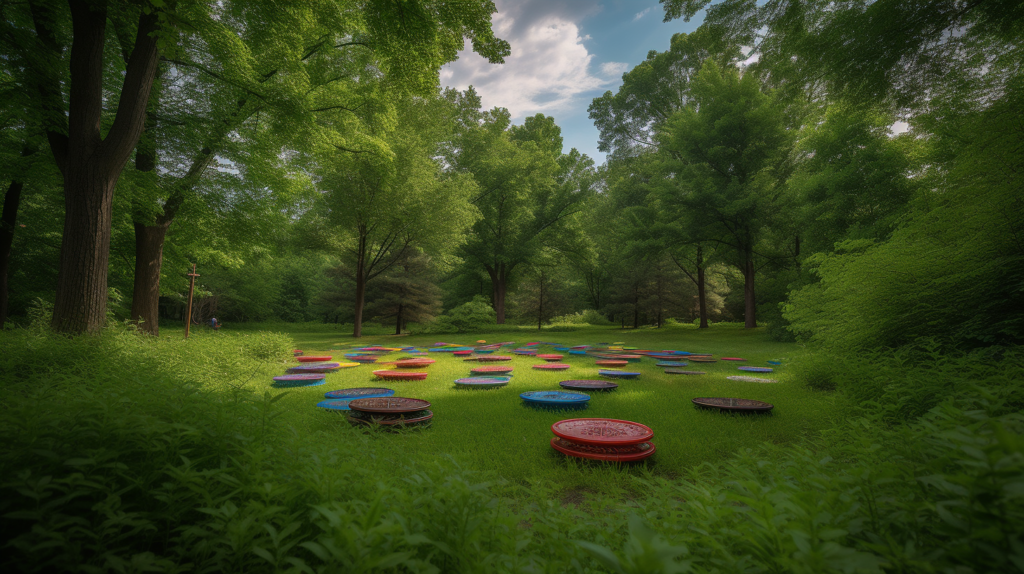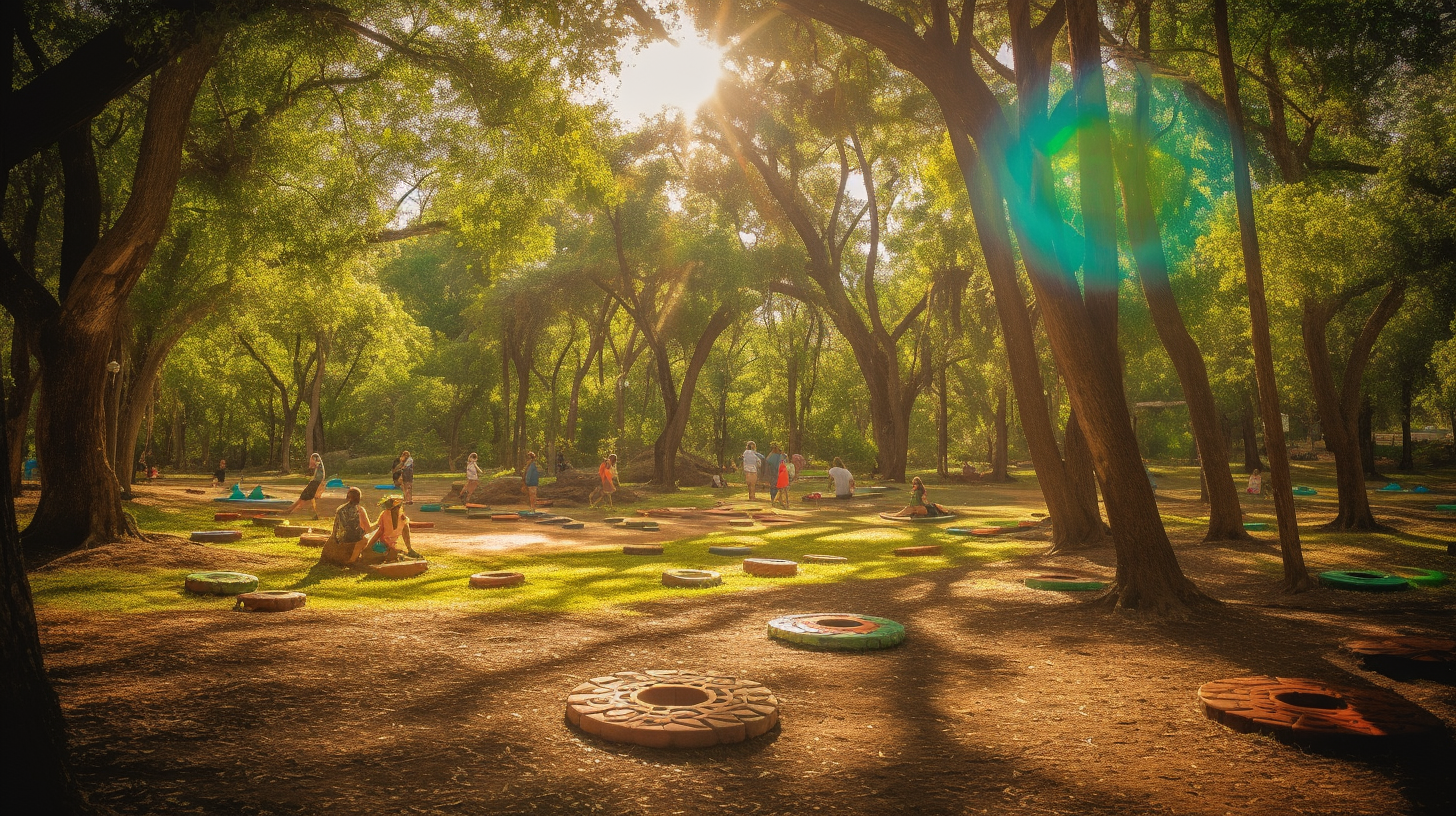With over 8,000 courses globally, have you spotted the unusual baskets and winding fairways of disc golf in your local park yet?
This unique flying disc sport combines key aspects of ball golf with the aerodynamic properties of the Frisbee to create a rapidly growing recreational and competitive activity suitable for all ages and skill levels.
Let’s dive in to explore what exactly disc golf is all about and how to start playing this addicting game!
What is Disc Golf?

Disc golf is a flying disc sport in which players throw a disc at a target; it is played using rules similar to golf. Instead of a ball and clubs, however, players use a flying disc or Frisbee.
The sport was relatively unknown until the 1970s, and has grown sharply in popularity since then as a professional and amateur sport.
Disc golf courses are usually laid out across a wooded or park area with a series of tee boxes and disc golf targets, known as disc pole holes.
The targets used in disc golf have chains, a basket, and pole very similar to what you see on a standard ball golf hole, only scaled down to fit flying discs. The goal for players is to complete each hole in the fewest number of total throws or strokes.
Whoever completes the course with the lowest total score is declared the winner, just as in regular golf.
Basic Rules and Objective

The objective of disc golf follows the same principles as regular golf in that players aim to complete all holes on the disc golf course in the fewest total throws or strokes.
The scoring works the same as well; players count the total throws on each hole and their final score is the sum or total number of throws to putt out on each disc golf basket. As in ball golf, the player with lowest total score wins the game or tournament.
Disc golf rules generally follow the same etiquette guidelines as ball golf, with some occasional differences specific to disc flight and throwing rather than using clubs. Out of bounds areas may be marked by white stakes just as they are in golf.
Players who throw “OB” must take a one-stroke penalty and throw again from the previous lie. Other penalties like strokes for lost discs, interference, or missing mandatory lines also apply similar to regular golf rules.
Equipment Needed

One of the main differences in equipment between disc golf and ball golf is that specialized flying discs are used instead of clubs and balls. Discs come in a variety of styles and models, generally divided into drivers, mid ranges, and putters.
Disc golf drivers have sharp, beveled edges that enable longer throws by cutting rapidly through the air. Mid range discs have rounded or blunt edges optimized for straight flight paths that do not fade or turn as severely right or left.
Putters have very blunt edges and sometimes rubbery grips to enable short controlled upshots and accuracy into the basket rather than distance.
Choosing the right discs is important depending on one’s skill level and play style preferences. Beginners generally do better starting with mid range discs and putters rather than high speed, sharp-edged drivers which require more skill to throw properly.
Heavier discs of 175 grams or above also tend to fly better in windy conditions. Discs have ratings for speed, glide, turn, and fade which help players decide the flight characteristics that best match their throwing style.
Other disc golf equipment like mini markers for marking disc position, towels for drying discs, gloves for consistent grip, and backpacks style bags for carrying discs comfortably are also popular among frequent players.
Good footwear like athletic shoes are important as well for traction on tee pads and hiking long courses through sometimes uneven terrain.
Where Can You Play?

Disc golf courses have been installed in hundreds of public parks worldwide thanks to the efforts of disc golf associations like the Professional Disc Golf Association (PDGA).
These park style courses utilize existing terrain like trees, bushes, elevation changes, water hazards, and other obstacles as part of the course layout to make for an interesting playing experience.
Championship level disc golf courses can be very demanding, requiring pinpoint accuracy off the tee and skillful approach shots while navigating past forests, creeks, sand traps, rock formations, and other challenges.
In addition to public parks, there are professional grade disc golf courses all over the world that more closely resemble ball golf courses, with tee pads, signage, pro shops, and well-defined fairways between sculpted, maintained holes.
Private disc golf country clubs with membership fees also exist for more serious players who want access to top-tier courses and facilities.
These professional level disc golf courses provide opportunities for players to improve their skills and raise their rankings in various regional and national tours and circuits. Some private clubs also offer club storage, events, leagues, clinics with pros, and other member benefits.
Course terrain and layout varies immensely, with open field style holes that require straight, accurate throws to hit gaps between trees way down the fairway. Heavily wooded courses demand tight precision shots threading narrow tree gaps off the tee pad.
Ideal disc golf course design features a diverse mixture of hole lengths and arrangements to challenge all skill levels.
Placement of water hazards, out of bounds zones, mandatories, and other obstacles also force players to evaluate risk-reward on each throw, adding to the appeal of the sport.
How to Get Started

The best way to learn the basics of disc golf for beginners is to find a friend or family member who already plays and can teach you the basics. Most disc golfers are more than happy to introduce newcomers to the sport and share their expertise.
Local disc golf clubs will also assist new players looking to give disc golf a try by loaning discs, providing course guidance, and explaining the fundamentals.
Many parks with disc golf courses hold weekly doubles leagues which welcome novice players paired with experienced club members who can provide tips and advice. Attending a beginner clinic is another great opportunity for introduction to disc golf fundamentals.
Local players are usually on hand to demonstrate grip, throwing motions, stances, and other techniques to new players in a clinic format. Lessons from a professional disc golfer can also rapidly improve throwing form.
When first starting out, it is generally wise to use putters and mid-range discs rather than immediately moving up to high-speed, sharp drivers. Learning proper throwing technique, nose angle control, snap, and wrist action fundamentals should be mastered first.
Rushing into using drivers before developing solid form often instills bad habits that prove difficult to correct later. Taking things slowly with putter in the beginning establishes sound mechanics.
While some play disc golf as a serious competitive outlet at professional tournaments, one of the allures as an amateur sport is that anyone at any age or skill level can play casually for pure recreation.
Group outings with friends or family are popular ways to get outdoors and active rather than overly technical. The benefits of disc golf for physical exercise combined with social interaction make it an enjoyable lifetime fitness activity for all generations.
Conclusion
Disc golf offers an enjoyable, low-cost outdoor activity for all ages to stay active. With exponential growth in recent years, courses are now installed in hundreds of parks worldwide thanks to groups like the PDGA.
Whether playing casual rounds for pure recreation or competing in tournaments, disc golf provides great exercise paired with social bonding. If you have yet to give disc golf a throw, grab a disc and head to the course!



